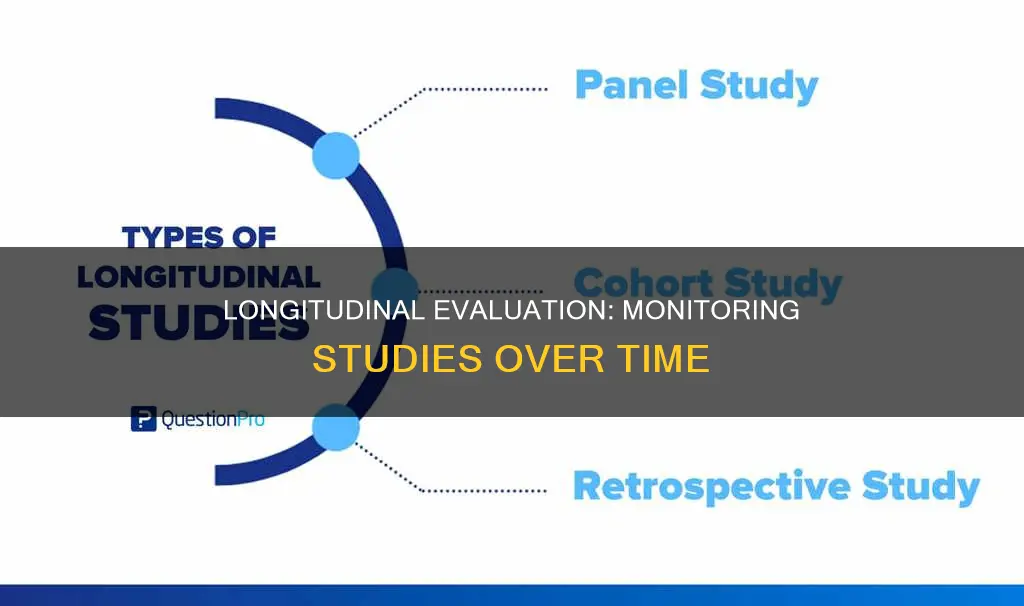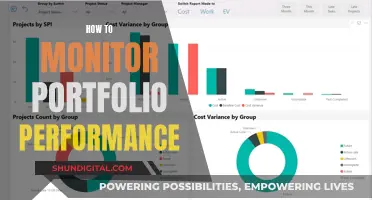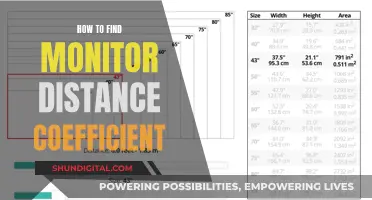
Monitoring and evaluation are two techniques used to assess the outcomes of a program or project. Monitoring is the process of collecting data about a program or project, including qualitative and quantitative data, and it happens continuously throughout the duration of the project. Evaluation, on the other hand, is a scientific process that assesses the effectiveness of a program or project by collecting, analysing, and interpreting data. This usually happens less frequently, such as annually or at the end of a project. One type of evaluation that monitors a study over time is a real-time evaluation, which is undertaken during the project implementation phase to provide immediate feedback for modifications and improvements.
| Characteristics | Values |
|---|---|
| Purpose | To monitor and evaluate the outcomes of a program or project |
| Timing | Continuous monitoring with evaluation at intervals, e.g. annually or at the end of a project |
| Data Collection | Collecting qualitative and quantitative data through various tools such as reports, surveys, interviews, etc. |
| Data Analysis | Analysing data to assess the effectiveness, success, and impact of a project |
| Decision-Making | Informing decisions by identifying issues and successes, and adapting strategies |
| Accountability | Ensuring transparency and accountability to stakeholders |
| Resource Efficiency | Helping to prioritise areas that need resources and prevent waste |
| Learning | Learning from mistakes, successes, and adaptations for future projects |
| Innovation | Encouraging innovative thinking and methods for data collection |
| Diversity | Encouraging diversity of thought and opinions from all team members |
What You'll Learn

Process monitoring
- It involves tracking the use of inputs and resources, such as funding, staff, and materials.
- It focuses on the activities undertaken to deliver the program's outputs.
- It is typically conducted during the initial stages of a project, but can also be carried out throughout the project's life cycle.
- It helps to identify any issues or deviations from the planned activities, allowing for course corrections and improvements.
- It provides data and insights that can be used to inform strategic decisions and resource allocation.
- It can be used to assess the long-term sustainability of the project by evaluating the effectiveness of the implemented activities.
By conducting process monitoring, organizations can ensure that the program is implemented as intended and can make any necessary adjustments to improve the likelihood of success. It is an important tool for project management and evaluation, providing data and insights to drive decision-making and strategic planning.
Dismantling Your ASUS LCD Monitor: Step-by-Step Guide
You may want to see also

Compliance monitoring
Identifying Relevant Regulations and Policies
This includes understanding the legal and regulatory landscape within which an organization operates, as well as any internal policies they have in place. This is crucial to ensure the organization is aware of all applicable compliance requirements.
Assessing Risks
Once the relevant regulations and policies are identified, the organization needs to assess the risks associated with non-compliance. This includes considering the potential financial penalties, reputational damage, and legal action that may result from failing to comply. By understanding these risks, organizations can prioritize their compliance efforts and allocate resources effectively.
Implementing Controls
After identifying the risks, the organization needs to put in place controls to mitigate those risks. These controls can be manual or automated and may include training employees, monitoring activity, and conducting audits. The controls are essential to ensure the organization actively works towards complying with the relevant regulations and policies.
Monitoring and Reporting
It is important to continuously monitor the effectiveness of the controls put in place. This involves regularly reviewing and testing the controls to ensure they remain effective over time. Additionally, reporting on compliance activities is crucial to keep stakeholders, such as management and regulatory bodies, informed about the organization's compliance status.
Capacitors in LCD Monitors: How Many Are There?
You may want to see also

Context monitoring
The data collected through context monitoring provides valuable insights for project planning and decision-making. It helps project managers and stakeholders make informed choices by considering the broader environment in which the project is being implemented. This type of monitoring also facilitates risk management and contingency planning, ensuring that the project can adapt to unforeseen circumstances.
In summary, context monitoring is a critical aspect of project management as it provides a broader perspective on the project's environment. By tracking external factors and potential risks, project teams can make more informed decisions, mitigate issues, and increase the chances of achieving their desired outcomes. Context monitoring is, therefore, a valuable tool for any organization seeking to optimize its projects and ensure successful outcomes.
Using Dual Monitors: Productivity Boost or Hindrance?
You may want to see also

Beneficiary monitoring
One approach to beneficiary monitoring is called Iterative Beneficiary Monitoring (IBM), which was developed by the World Bank as a low-cost, iterative feedback loop. IBM collects information directly from beneficiaries and produces focused reports on challenges that need to be addressed. By regularly repeating data collection, positive, self-reinforcing cycles of improvement are created, leading to more effective projects.
IBM is particularly useful in situations where there is limited access to project activities due to conflict or other security concerns. Its low-cost approach also makes it attractive for projects in secure settings. When designing an IBM system, it is important to keep the data collection exercise light and focused, ensuring that the methodology and instruments for data collection are validated by project managers to ensure accuracy and buy-in.
Another key aspect of beneficiary monitoring is confidentiality. It is important to keep the identities of respondents and the locations where data are collected confidential to prevent any potential bias in the results. This helps to build trust with the beneficiaries and encourages honest feedback, which is crucial for effective monitoring.
Overall, beneficiary monitoring is a valuable tool to ensure that projects are meeting their intended goals and benefiting the intended recipients. It provides a direct channel for feedback and can help identify issues or concerns that may not be apparent to the project team, ultimately leading to more successful and sustainable projects.
Removing AOpen Monitor Stands: A Step-by-Step Guide
You may want to see also

Financial monitoring
Financial Performance Indicators
Financial performance indicators, also known as key performance indicators (KPIs), are quantifiable metrics used to assess a company's financial health and performance. These KPIs include metrics such as gross profit margin, net profit margin, working capital, operating cash flow, current ratio, debt-to-equity ratio, inventory turnover, and return on equity. These indicators provide insights into a company's profitability, liquidity, solvency, and efficiency.
Financial Statements
Financial statements are essential tools for financial monitoring. The three primary financial statements are the balance sheet, the income statement, and the cash flow statement.
- Balance Sheet: This statement provides a snapshot of a company's financial position at a specific point in time. It includes information about assets, liabilities, and shareholder equity, offering insights into operational efficiency, debt obligations, and equity capital investments.
- Income Statement: The income statement summarises a company's revenues, expenses, and profits over a specific period. It helps analyse business efficiency and provides metrics such as gross profit margin, operating profit margin, and net profit margin.
- Cash Flow Statement: This statement captures the cash inflows and outflows from operating, investing, and financing activities. It reconciles net income with cash flow, providing insights into stock repurchases, dividends, and capital expenditures.
Types of Financial Analysis
There are two main types of financial analysis: fundamental analysis and technical analysis.
- Fundamental Analysis: This approach uses financial ratios and statement data to determine the intrinsic value of a security. It focuses on analysing earnings per share (EPS), return on assets (ROA), and other financial metrics to assess the stability, solvency, liquidity, and profitability of an entity.
- Technical Analysis: Technical analysis assumes that a security's value is determined by its market price. It studies statistical trends, moving averages, and price movements to predict market behaviour and identify patterns.
Monitoring and Evaluation (M&E)
M&E is a continuous management function that assesses progress towards expected results. It identifies bottlenecks and unintended effects of an investment plan, programme, or project. M&E includes progress/implementation monitoring, process monitoring, and results monitoring. It enhances effectiveness, promotes accountability, and facilitates learning and innovation.
In summary, financial monitoring plays a crucial role in evaluating a study over time by providing quantitative and qualitative data, analysing financial performance, and guiding decision-making. It involves tracking key financial indicators, conducting financial analysis, and utilising monitoring and evaluation techniques to assess the financial health and performance of a project or entity.
Performance Monitor in SQL Server: A Comprehensive Guide
You may want to see also
Frequently asked questions
Monitoring and evaluation are two techniques for assessing the outcomes of a program or project. Monitoring is the process of collecting data about a program or project, while evaluation is the process of assessing the effectiveness of a program or project. Both techniques are critical for an organization to keep track of the progress of its programs and projects.
Monitoring involves the collection of data, monitoring progress, and tracking key performance indicators. It is often conducted continuously and can include internal and external monitoring. On the other hand, evaluation is a scientific and systematic process that involves the collection, analysis, and interpretation of data to gauge the success of a project in meeting its objectives. Evaluation determines the merit, worth, value, or significance of a project.
Monitoring and evaluation are important for several reasons. They improve transparency and accountability, help organizations catch problems early, ensure efficient resource use, provide learning opportunities from mistakes, improve decision-making, and promote innovation and diversity of thought. Additionally, they help organizations stay organized and replicate successful projects, contributing to their overall success and sustainability.
There are various types of monitoring and evaluation, including process monitoring, compliance monitoring, context monitoring, beneficiary monitoring, financial monitoring, and organizational monitoring. For evaluation, there are types such as formative evaluation, process evaluation, outcome evaluation, summative evaluation, impact evaluation, real-time evaluation, and participatory evaluation. These types can be combined in different ways to suit the specific needs of a project.







